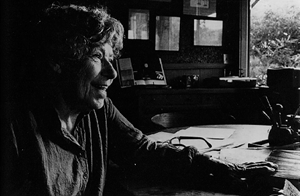
Who is Helen Hosmer and how does she connect to Raymond Chandler? |
||
|
6 Degrees of Separation |
|
Six degrees of separation refers to the idea that, if a person is one "step" away from each person he or she knows and two "steps" away from each person who is known by one of the people he or she knows, then everyone is no more than six "steps" away from each person on Earth. (from Wikipedia) As an aside, while researching Chandler's father on Ancestry.com I came upon a page of famous people related to his father, hence related to Raymond Chandler as well. If this isn't 6 degrees of something I don't know what is! Check out the PDF "FamousRelatedMBChandler." Since 1963 The Regional History Project at the University of California, Santa Cruz has been documenting the history of the Central Coast of California with oral histories. All of the histories are available to the public. Included in the Agricultural History of Santa Cruz County is the oral history of: Hosmer, Helen (1904-1984) 1992, 116 pp. 1 illus. (as a PDF document) Helen Hosmer: A Radical Critic of California Agribusiness in the 1930s 
"Helen Hosmer was a writer, activist, and historian of California agribusiness. Her knowledge of California's agriculture dated back to the 1930s when, as a student at the University of California, Berkeley she worked at the Poultry Division, College of Agriculture. Later she worked for the Information Division of the Farm Security Administration (FSA), which established camps for migrant workers in California. During this period Hosmer came to know FSA photographer Dorothea Lange, agricultural economist Paul S. Taylor, and many important figures in the labor movement in San Francisco. Because of her conviction that labor organizing was essential among agricultural workers, Hosmer resigned her government position at Farm Security in 1935 in order to have the freedom to work in behalf of her political beliefs. She co founded the Simon J. Lubin Society, an organization that promoted unity between family farmers and migrant labor and exposed the antiprogressive political activities of California agribusiness. From 1935 to 1941 she published and edited the Lubin Society's Rural Observer. The Society also issued special publications, such as Who Are the Associated Farmers? (reproduced in this volume) and John Steinbeck's Their Blood is Strong." "Hosmer's memoirs also discuss California intellectual, cultural, and political life in the 1920s, and 1930s, red-baiting, the San Francisco General Strike and the Criminal Syndicalism trial, and the La Follette Civil Liberties Committee. After World War II, Hosmer temporarily put aside her political activism and spent over 25 years living in Mill Valley as a housewife, mother, pianist, and gardener. In the early 1960s she resumed her research and writing. She again turned her attention to California agriculture, writing articles for American West magazine, and serving as director for the research committee for the California Farm Reporter." From the oral history: "Jarrell: It is 9 pm, August 26th, and I'm in Summerland, California, with Helen Hosmer at her home. To start with, would you please give a description of your family, and tell me where you were born and in what year." "Hosmer: Well, I was born in Philadelphia on March 31, 1904, and brought to California when I was three. Of course in those days California was the land of milk and honey and the sweet smell of orange blossoms from one end of Los Angeles to the other. It was, of course, before freeways and before smog. Can you imagine how beautiful it was then? I was from a lower-middle-class family; my father and mother were very poor. We had a darling little house, in Highland Park, just ten blocks from where Charles Loomis, the famous California historian, had his beautiful adobe house right on the Arroyo Seco River. My childhood was greatly glamorized by the fact that he met me up in the hills one day when I was 12 years old and said, "You like these flowers?" I said, "Yes, I love my hills. They're mine." He asked my name. I told him and said I had a sister named Sylvia. He said, "That's beautiful, it's like the woods. You know, I give a 'noise' on Sunday nights and I like you and I'm going to invite you to come to my 'noises.' You mustn't bring your mother or your father or anybody else." I said, "Not even my sister?" "Well, because her name is Sylvia, you can bring Sylvia. But you aren't to bring anyone else. I will phone your parents when I have the next 'noise.'" Charles Loomis's "noises" consisted of the most glorious gatherings of talented people you have ever heard of . . . opera singers, writers, musicians. Will Rogers came and stood there and told story after story chewing his gum. People from the opera companies, violinists; an Indian man came and told a whole story in sign language with an interpreter. Every time he phoned, we wore our same little white organdy dresses which was all we had. Our father would walk us down with the greatest misgivings because for years Charles Loomis in that neighborhood had been considered a mystery man, and nobody really trusted him . . . Great chauffeur-driven limousines would roll up and these elegant ladies in evening gowns and men in full dress stepped out of the cars. The neighbors would all peer and chatter and wonder what went on in there. And to think that we two little girls were privy to all of this. . . well, that was one of the things that happened to me in Los Angeles . . . my first taste of real top-notch glamour. " "I think the most important things to me were the mustard blossom and the Indian paintbrush and the lupine that grew on these hillsides in back of our house. That was virgin land; nobody had ever burned them back before. The mustard blossom grew way taller than my head . . . you had to part it to go through it. To this day the smell of mustard blossom is one of the most important California smells I know. Jarrell: When you were in high school, what were you like, and what were you interested in? Hosmer: I was interested more than anything else in dancing. But my mother thought there was something absolutely, well, if not obscene, at least immoral about dancing, becoming a dancer. Instead of doing my gymnastics, I used to go off in a corner in the gym class and make up dances. And believe it or not, Myra Kinch and Agnes DeMille took me up and made me perform at the high school auditorium once a week at the assembly . . . anything I could make up on the spur of the moment. They went to my mother together and pleaded with her to let them give me dancing lessons. And I begged my mother but she was absolutely adamant and would not let me study with Myra Kinch and Agnes DeMille . . . my whole life probably would have been quite different. Because that was the one thing I wanted more than anything on earth, and I never really got it. " "Hosmer: I wasn't trained for anything but philosophy. And I did lots and lots and lots of piano. And very early on I met this girl, Marjorie Petray. And she began to give me ear training, some harmony, and piano lessons." Jarrell: "Had you ever taken piano before? " Hosmer: "When I was a child. This lady came to the door. . . I remember she had a diamond for a filling in her front tooth, and she charged 50 cents a lesson. She came once a week to teach me. She would count 1 & 2 & . . . long after I'd finish the piece and sitting there with my hands folded, she was still counting. (Laughter) I think she was dreaming about her diamond mine or something, I don't know. She taught me horrible songs like, "Just a little love, a little kiss." Whatever anybody wanted, she taught me . . . I didn't know one note from another, but somewhere along the line, then, they took me to a teacher, Mr. Julian Pascal, and he taught me some high-falutin' music with a stop watch. (Laughter) 'Cause it wasn't how you played, it was how fast you could go. He made me learn some Chopin Nocturnes and the Black Key Étude of Chopin's. Like the wind . . . with my foot on the pedal that never came off, it stayed on through the whole piece. (Laughter) And the Rachmaninoff Prelude . . . and then whenever my left-wing parents had big parties, or mass meetings or anything else, they trotted me out and forced me to perform. My foot would shake so badly on the pedal." There you have it - the link between Helen Hosmer and Raymond Chandler is Mr. Julian Pascal, Helen's high-falutin piano teacher who was of course the husband of Pearl Pascal who became Mrs. Raymond T. Chandler.
© 2007 Loren Latker
|
||